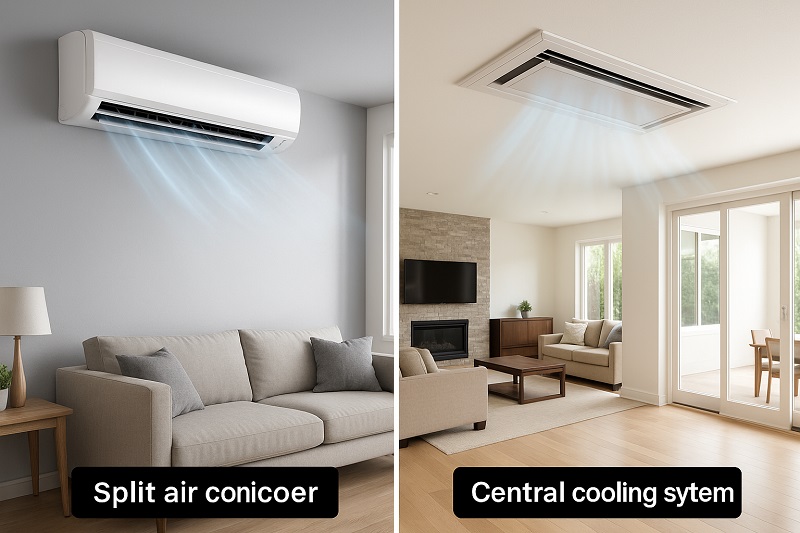Quick Answer: Single Split Aircon vs Central Cooling
A single split aircon is best for small homes, targeted cooling, and lower installation costs, while a central cooling system suits larger homes needing even, whole-house temperature control. Split ACs are ductless, quiet, and energy-efficient for zoned areas, whereas central systems use ducts and offer better air filtration and whole-home comfort. The best choice depends on your home size, climate, and energy goals.
As temperatures rise and climate variability increases, many homeowners are debating the question: Single Split Aircon vs Central Cooling — which is better? Whether you’re renovating, building, or just trying to cut energy costs, choosing the right air conditioning system is critical. This guide compares both systems in detail, helping you decide which one suits your space, budget, and lifestyle.
Comparison : Single Split Aircon vs Central Cooling
| Feature | Single Split Aircon | Central Cooling System |
| Best For | Small to medium spaces | Whole-house, large homes |
| Cost (Install) | $2,500 – $4,500 per zone | $6,000 – $12,000 (with ducts) |
| Annual Operating Cost | ~$300–$700 per unit | ~$800–$1,600 (varies by size) |
| Efficiency Rating (SEER) | 18–28 SEER (high) | 14–20 SEER |
| Zoning Control | Excellent (one head = one zone) | Moderate (requires dampers) |
| Noise Level (Indoor) | 19–35 dB (very quiet) | 50–60 dB |
| Aesthetic Impact | Minimal wall-mounted heads | No indoor units; hidden ducts |
| IAQ & Filtration | Basic mesh filters | Advanced filters (MERV 13+) |
| Heating Capable? | Yes (many are heat pumps) | Yes (with furnace or heat pump) |
| Tax Credits/Rebates | Up to $2,000 (U.S. §25C) | Available, varies by system |
Understanding the Single Split Aircon
A single split air conditioner is a ductless cooling system made of two parts:
- Indoor unit: Mounted on the wall or ceiling.
- Outdoor unit: Houses the compressor and condenser.
Ideal for homes without ductwork, this system offers localized cooling, minimal installation hassle, and excellent energy efficiency for targeted areas.
✅ Benefits of Single Split Aircon
- Efficient zone control: Cool only the rooms you’re using.
- Easy installation: No ducts = less disruption.
- Lower upfront cost for small spaces.
- Quiet operation: Many units run at 19–25 dB.
- Modern aesthetics: Sleek units blend into modern homes.
- Dual function: Heating + cooling via inverter tech.
❌ Drawbacks of Single Split Aircon
- Not ideal for large homes: Multiple units may be needed.
- Maintenance per unit: Each head needs periodic care.
- Outdoor units may clutter exterior walls.
- Basic air filters: Less effective than central systems.
Central Cooling Systems Explained
A central cooling system cools your entire home through ductwork, distributing air via ceiling or floor vents.
✅ Benefits of Central Cooling
- Uniform temperature: Consistent comfort across all rooms.
- Discreet setup: Indoor aesthetics remain untouched.
- Integrated air quality controls: Filters, UV, and humidity control.
- Centralized control: One thermostat for the whole house.
- Boosts resale value: Often preferred in home appraisals.
❌ Limitations of Central Cooling
- High installation costs: Especially for ductless homes.
- Energy waste: Cools unoccupied rooms without zoning.
- Duct leaks and inefficiencies: May lose up to 30% of cooled air.
- Slower installation: More invasive and time-intensive.
Comparing Energy Efficiency: Single Split Aircon vs Central Cooling
SEER Ratings Matter
- Split systems: Often rated between 18–28 SEER, with advanced models reaching 30+ SEER.
- Central systems: Typically 14–20 SEER, though some variable-speed models improve modulation.
Energy Cost Example
| Scenario | Split Aircon (SEER 20) | Central Cooling (SEER 15) |
| Monthly kWh for 1,000 ft² | ~150–200 | ~300–400 |
| Monthly Cost (@ $0.15/kWh) | $22–$30 | $45–$60 |
Climate, House Type & Comfort Fit
Which Works Best Where?
- Split systems: Ideal for apartments, retrofits, garages, and homes without ducts.
- Central systems: Better for large, multi-room homes in hot climates.
️ Climate Consideration
- Split aircons may struggle in extreme heat if undersized.
- Central cooling handles humidity better with integrated dehumidifiers.
Indoor Air Quality & Health
| Factor | Single Split Aircon | Central Cooling System |
| Filtration | Basic mesh or ion filters | HEPA, UV light, MERV 13+ upgrades |
| Humidity Control | Limited | Full-house dehumidifier options |
| Air Distribution | Localized | Whole-house |
If allergies or asthma are concerns, central cooling has an edge with more advanced air quality tools.
Zoning, Smart Controls & System Flexibility
- Split ACs: Built-in zoning; each indoor head = one zone.
- Central systems: Need motorized dampers and smart thermostats for zoning.
Smart Features
- Split systems: App-controlled, voice-assistant compatible, programmable.
- Central systems: Smart thermostats (e.g., Ecobee, Nest), some offer room sensors.
Installation, Maintenance & Cost Over Time
| Cost Factor | Single Split Aircon | Central Cooling System |
| Installation | $2.5k–$4.5k per zone | $6k–$12k (plus ducts) |
| Maintenance | ~$150 per head/year | $400–$700/year |
| Lifespan | 12–20 years | 15–20 years |
| Duct Cleaning Needed? | ❌ | ✅ Every 3–5 years |
Environmental & Incentive Factors
Refrigerant Considerations
- Split systems often use R-32 (GWP 675).
- Older central systems may still use R-410A (GWP 2,088).
Tax Credits & Rebates
- Split aircon units that qualify under ENERGY STAR may receive up to $2,000 U.S. tax credit (Section 25C).
- Local rebates vary but can stack with federal incentives.
Frequently Asked Questions
Is a single split aircon better than central cooling?
It depends on your home size and layout. Split ACs are great for zoning, while central systems are ideal for consistent whole-home cooling.
Do I need ducts for a split system?
No, split aircons are ductless and are perfect for older homes or additions.
Which is cheaper to run long-term?
Split systems are cheaper for small, zoned areas, while central can be more efficient for large homes with proper zoning.
Final Verdict: Single Split Aircon vs Central Cooling
When it comes to Single Split Aircon vs Central Cooling, the winner depends entirely on your situation:
- Choose a split system if you want lower installation hassle, room-specific control, and top-tier energy efficiency in a compact space.
- Opt for central cooling if you want whole-house uniformity, better indoor air quality, and hidden hardware with seamless thermostat control.
By considering your climate, home layout, energy goals, and budget, you’ll make a smarter investment that keeps your home cool for years to come.





